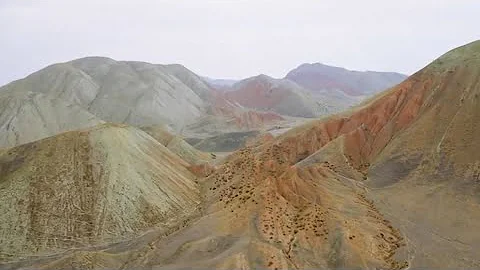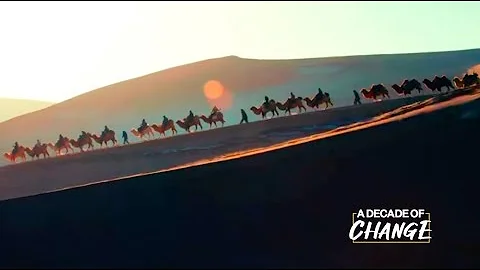Lizhuang is prosperous because of the Yellow River and is named after the Yellow River.

"The Yellow River has nine bends and eighteen bends" is a vivid saying. It originates from the Qinghai-Tibet Plateau. It twists and turns among the high mountains, valleys and highlands. No one can accurately count the number of bends. But in terms of its general trend, it starts from Kunlun in the west, reaches Jishi in the southeast, then turns to the northwest, then turns northeast to Lanzhou, and then northeast to form a Hetao, flowing down the Pushan Grand Canyon, connecting to Tongguan in the south, turning to the east, until Guantai, Lizhuang Town, Fengqiu County, turns to the northeast and flows into the sea along the Guji River. It passes through nine provinces and is 5,464 kilometers long, with a total of six big bends. This sixth big bend is also the last bend. Books about the Yellow River are mostly called "Lan Kao Bay", but in fact, the more accurate term is "Lizhuang Bay". Because the area around Lizhuang Town in Fengqiu County used to belong to Lanyang , which is now Lankao, Lizhuang Town is in the center of this big bend. The difference between this big bend and the other five big bends is that the five big bends in the upper and middle reaches are all The Yellow River is a relatively fixed river course, but this bend was the only one formed during the Great Migration of the Yellow River in the 5th year of Xianfeng in the Qing Dynasty (AD 1855). This migration, known as Tongwaxiang Creation in history, is the sixth of six major changes in the course of the Yellow River since the beginning of written records in 602 BC, and it is also the last one so far. In the 7th year of Hongzhi's reign in the Ming Dynasty (AD 1494), the Yellow River took Bian and entered the Si River, joined the Huai River and entered the sea (historically known as the fifth major diversion of the Yellow River). , so far, the 361-year situation in which the Yellow River has occupied and the Huaihe River has entered the sea has come to an end.
Tongwaxiang was in Lanyang (Lankao) County and now belongs to the north bank of the Yellow River in Lizhuang Town, Fengqiu County. The Yellow River comes from the west and slowly turns southeast from here. It was a dangerous place on the Yellow River during the Ming and Qing Dynasties. In the fifteenth year of Wanli in the Ming Dynasty (1587 AD), a sudden overflow occurred here. Qingheji in Fengqiu also passed by. During the Daoguang and Xianfeng periods of the Qing Dynasty, the lower reaches of the Yellow River entered the sea through the Xuzhou Huaihe River channel, which was seriously silted up. In addition, the distance between the embankments on both sides became narrower toward the downstream, and the drainage capacity was extremely poor. Therefore, "the lower reaches will collapse when they stick to the upper reaches." The upstream sticks to its will and the bottom collapses.”
finally led to this big break. "Fengqiu Yellow River Chronicles" compiled in 1984 described the process of the breach like this:
"In mid-June of the fifth year of Xianfeng, a major flood occurred in the Yellow River. From the 15th to the 17th, the water level in the lower reaches continued to rise....+ On the night of the tth day, there was another heavy rain, and the water became more turbulent, so that both sides of the bank were flooded as far as the eye can see, and there were many places where the dike water was level. Immediately, three or four feet collapsed, leaving only a large number of piles on the top of the embankment, and bricks and stones to protect it. That night, there was a strong wind and rain, strong winds, and huge waves. On the 19th, this section of the dike finally collapsed. On the 20th, the whole river will be captured."

After the Tongwaxiang breach, it flooded villages in Lanyang, Yifeng, Kaocheng, Fengqiu, Changyuan and other counties. The disaster spread to Henan, Zhidong, and Shandong, causing immeasurable damage to the lives and property of the people in the three places. loss. The rulers at that time debated for nearly 30 years whether to block or not to block. In the end, we could only let it go, resulting in the current situation.

Regarding that disaster, it can be seen from the "Fengqiu Place Names": "Guantai is 38 kilometers southeast of the county. In the fifth year of Xianfeng, the Yellow River burst, and the dinan river beach was hit. The Qing government built a high platform here to store money and grain. It was placed on the platform to relieve the victims. At that time, copper coins were made into a bunch of 500. After the village was established, it was named Guantai. It was called Guantai Town in the Republic of China and later called Guantai Ji... It is one of the main ferries connecting the north and south. one". "Kuzhuang...originally named Anlezhai. In the fifth year of Xianfeng Period in the Qing Dynasty, the Yellow River overflowed, houses collapsed, the land was submerged, and life was difficult, so it was renamed Kuzhuang."
"Zhugang... In the fifth year of Xianfeng in the Qing Dynasty, the Yellow River burst in Tongwaxiang, and the refugees moved to live on the hillside. Because there was a bamboo forest in the west of the village, it was named Zhugang."

Hou Xinzhuang....In the fifth year of Xianfeng Period in the Qing Dynasty, the Yellow River burst and the village was flooded. The village site was moved westward and was named Xinzhuang, which later evolved into Xinzhuang. The village expanded and was divided into two parts, the north and the south. The south was called Qian Xinzhuang and the north was called Hou Xinzhuang...
One part is the history of the Yellow River and half is the history of China. According to statistics, there are written records in the fifth year of King Zhou Ding (AD From 602 BC) to the 22nd year of the Republic of China (1933 AD), in 2535 years, the Yellow River overflowed and flooded a total of 2546 times, an average of more than once a year.The frequency and brutality of floods are vivid and vivid in history. The rulers of all dynasties have had a headache in managing the Yellow River. When a wise king and a wise minister invest huge amounts of money and work hard for the people, although there are some results, it is difficult to coordinate and solve the problem; when a weak king and mediocre officials often use internal and external troubles as an excuse, they let it flow, destroying villages and families, and leaving the people homeless. regardless of.
to 2014, the Party Central Committee, the State Council, the Provincial Party Committee and the Provincial Government brought good news to the people of the beach area of Lizhuang. Under the correct deployment and strong leadership of the Fengqiu County Party Committee and County Government, the Lizhuang Town Party Committee and Government led and organized the masses to work day and night, forgetting to eat and sleep, to invest in the overall relocation of the Yellow River Beach District, a project to bring peace to the people and benefit the people. The first batch of relocations included 5 villages, Zhangzhuang, Yaozhuang, Xueguozhuang, Nancao, and Guantai, with a total of 2,053 households and 7,634 people; the second batch of relocations included Qianxinzhuang, Houxinzhuang, Erwan, Lizhuang, and Zhangcao There are 3,920 households and 13,885 people in the 5 villages.

has moved into the new area one after another since December 2015. The community situation is stable, and there has been no accident or petition in Ngee Ann. On the one hand, it shows the wisdom of national policies, on the other hand, it also shows that the Fengqiu County Party Committee and County Government has clear guiding ideology, effective methods and measures, linkage between top and bottom, and collective efforts. It is the crystallization of wisdom and sweat. Poverty alleviation and overall relocation in beach areas are unprecedented in previous dynasties. This shows the determination and courage of the Party Central Committee and the State Council and the Henan Provincial Committee and Provincial Government to eradicate the Yellow River. It also shows the infinite care of the Party Central Committee and the State Council for the people along the Yellow River.
"The water of the Yellow River comes from the sky." The Yellow River, which was born 500 million years ago, starts from the Lierquna Sliding River in the Yuegu Zonglie Basin of the Qinghai-Tibet Plateau. It carries the Xingxiu Sea, merges with the Zhaling Lake and the Eling Lake, and the Heihe and Baihe Rivers, and connects with the Huangshui River. It covers Weifen, accepts Luo, and turns thousands of times: roaring and galloping, it has reached thousands of miles. It has a fate with Lizhuang, so why not turn a corner here? There must be many factors here, and these many factors have created the style and quality of Lizhuang. The old Yellow River embankment winds its way to the west and passes through the Meng embankment to the north. The two embankments meet here and the dam is majestic. The spring grass is green and the warm breeze is blowing. Standing at the head of the dam, looking up and down, the Yellow River bends around like a jade belt, surrounding this vast, flat and fertile beach soil. Looking at the sky from a distance, the fertile fields are flat, the river birds are flying, the sky is high and the clouds are far away, which makes people suddenly think of connecting with the heaven and the earth, and the eyes are relaxed and happy. This is the place where the Guji River flows and turns. It is connected to the west by Gupingqiu, the historical town , Chenqiaoyi and the ancient Huangchi. Linji, the capital of the Wei state at the end of the Qin Dynasty, was located here, and it was also the central area of the ancient feudal lordship state. In history, the Mingtiao of the "Battle of Mingtiao", the last battle between Shang Tang and Xia Jie, is also recorded here. This is also the place where several vassal states including Song, Wei, Wei, Cao and Chen fought in ancient times. Until modern times, it still belonged to the three counties of Ying, Chenliu and Xiangfu. It was not until 1949 that it was placed under Fengqiu. Why the boundary is drawn here is also a unique feature of this place. There must be geological, geographical location, terrain and other reasons as well as humanistic factors. Coupled with the fame of Tongwaxiang, Lizhuang has become an excellent place for cultural research, investigation and sightseeing of the Yellow River, Jishui, ancient regions, place names, folk customs, history and other cultures. Especially after the relocation work of the beach area was started, a new modern small town emerged at the bend of the once vast Yellow River. Looking at the word "house" from a distance and watching the lights at night, it formed a bright spot at the bend of the Yellow River and was the cause of the Yellow River's harm. Another remarkable demonstration of blessing. The Yellow River, loess, and yellow skin, these unchanging genes and colors, have created the gentle and kind character and quality of the Chinese nation. As a member of the Chinese people from Fengqiu, the people of Lizhuang are fortunate to have a huge river at their doorstep. It is a great blessing to see the water turn from harm to benefit during the prosperous times, and to enjoy the benefits of government and benefit the people.





















